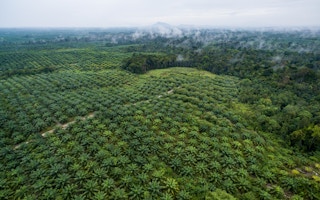The production of palm oil in Asia has been tarnished with issues of land degradation, biodiversity loss and human rights violations. Value chains are coming under greater scrutiny by regulators and investors while more attentive consumers are questioning the impact of their purchases. As a result, agri-companies are taking greater steps to conform to the rising environmental, social and governance expectations placed upon them.
To tackle these issues and reduce its impacts on biodiversity, palm oil company Musim Mas has undertaken various conservation efforts over the past decade. Musim Mas has adopted the high conservation value (HCV) methodology and High Carbon Stock Approach (HCSA) in accordance with the requirements set by the Roundtable on Sustainable Palm Oil (RSPO).
The firm has set aside areas identified as important for biodiversity and carbon absorption and co-opted stakeholders such as local communities to help manage these conservation areas. Monitoring and data collection is done using satellite imagery, camera traps, field monitoring, as well as training on-site staff.
In its latest drive for biodiversity conservation, Musim Mas has partnered with South East Asia Rainforest Research Partnership (SEARRP) to assess the impact of its conservation efforts over the past ten years, figure out its blind spots, and recalibrate where necessary.
Taking an honest look at the company’s conservation efforts is a “colossal task” but shows a commitment to improving both the company-wide and industry-wide conservation efforts as it involves analysing and making sense of the data across Musim Mas’ conservation areas, said director of SEARRP, Glen Reynolds (GR).
The project involves analysing the data and assessing Musim Mas’ existing conservation efforts, working closely with the company to increase the efficacy of their monitoring protocols, and then devising actionable recommendations to improve its overall conservation efforts.
One of the aims of this project is that the findings trickle down to the rest of the members of the RSPO, of which both Musim Mas and SEARRP are a part of, said Olivier Tichit (OT), director of sustainability at Musim Mas.
In this interview with Eco-Business, Reynolds and Tichit share what to expect from this partnership, the importance of analysing the wider landscape on top of the plantation estates themselves, and the challenges that may arise in setting out to improve conservation efforts.
Why did Musim Mas decide to undertake this partnership with SEARRP and vice versa?
OT: Musim Mas is a member of RSPO, Palm Oil Innovation Group (POIG) and HCSA and as part of these commitments, we have to identify and protect conservation areas, as well as monitor what’s happening in those areas. But having collected all this data, the important questions are what’s the impact that we’ve made? How can we revise our procedures if necessary? How can we do better?
It’s important for us to link up with organisations like SEARRP because they are scientists, and at the core of it, we are growers. After collecting so much data over the last ten years, SEARRP will now be able to analyse and make sense of our data. We also hope that what we find out through this assessment will trickle down to the RSPO and help others to better monitor and understand the impacts they are having.
GR: SEARRP is an independent science-based organisation, not a conservation NGO. So we’re just working with Musim Mas to understand what interventions work with respect to the company’s high conservation value approaches, and which don’t. It’s quite important to emphasise that we’re not just looking within the estates themselves, but also looking at the wider landscape and attempting to tease apart what effect it might have on biodiversity within a plantation. For example, if the estate is surrounded by forest, or if it’s surrounded by other land uses, are there different impacts on biodiversity conservation?
Do you have any inkling of what the results might reveal? What are some areas of improvement that you think currently exist?
OT: We are hoping to see species diversity increase over time in the conservation areas, but of course, we might also see some reduction in species. That will lead us to question why did it happen? Is it a natural process or is there something that we can do differently in those areas? Is it due to the areas outside of our estates? It could be that outside of our estates, there aren’t enough conservation areas in the forested area, and it affects our estates. If there have been high rates of deforestation in the wider landscape, biodiversity might reduce even if we have 1,000 hectares of conservation.
GR: We’re not seeing anything too shocking in terms of either biodiversity losses or gains, but at this stage, it’s too early to tell. I believe there’s reason to be optimistic though.
How would you compare Musim Mas’ existing conservation efforts to the best practices that you’ve seen on the ground?
GR: It is rare within the industry to invite a collaboration with an independent research programme so it indicates a seriousness that Musim Mas has to better understand the impacts of their efforts—both the good and the bad. While this formal partnership between Musim Mas and SEARRP is relatively recent, we’ve been engaged with the company for a long time through working groups and various RSPO committees that we jointly sit in. It’s been encouraging to see how Musim Mas has taken our previous recommendations and implemented them on the ground.
When can we expect the results from SEARRP’s analysis to be out?
OT: Covid-19 has played games on us. So everything has been a bit delayed, but by the middle of 2022, we’re hoping to get to the final results of the analysis and the recommendations from SEARRP. And based on that, then we will start our internal work of digesting—the first step would be improving our monitoring protocol and data collection and analysis. We are hoping SEARRP will train us so that we can start to analyse the data better internally.
The part that will take us a bit more time is the recalibration after, working out where to redirect our efforts and how to improve our conservation efforts for greater impact. That will take deeper redesigning, which will be part of the work plan for 2023. If the analysis shows that there has been a reduction of species diversity, we will have to evaluate if we are able to correct the situation or if it’s beyond our means because we do not have a big enough impact on the wider landscape. I think this will challenge us as we might need partnerships in the area.
Do you foresee any challenges in implementing these changes?
OT: I don’t expect too many challenges. The biggest challenge would be in the areas that involve the wider landscape. In some landscapes, we might find ourselves in a bit of a pickle because some of our neighbours might not have been exposed to the same level of conservation commitments as we have. So it might take more time to explain why it’s important to improve our conservation efforts. What can we achieve together?
How has Musim Mas navigated the more challenging landscapes that involve a wider set of stakeholders?
OT: I would say, with great difficulty, like everybody else. We try first to lead by example, to show people that you can be fully committed to conservation and sustainability and still run a profitable business. Sorry if it’s not a purely conservationist’s mentality but it’s important to show people that being a sustainable business can still be profitable. It’s something that we still need to demonstrate everyday, to convince people everyday.
We also work hard to prevent conflicts between stakeholders, for example through a partnership with the Flying Squad. That’s a long-term partnership with Tesso Nilo National Park Foundation to reduce human-elephant conflict. It’s been ongoing for fourteen years and counting.
One of the things that are rarely recognised about plantation companies—in particular, palm that has a cycle of 25 years—is that we’re always thinking in long cycles. I think both industry and the conservation sector do not leverage that enough.
















